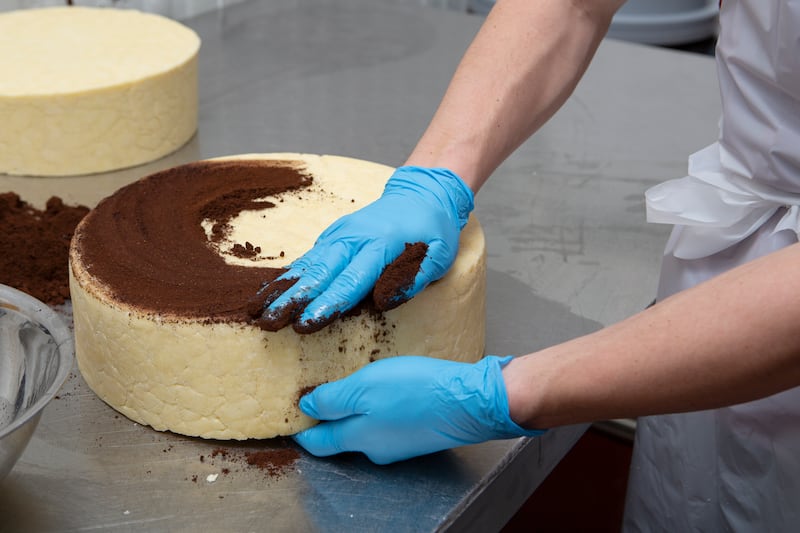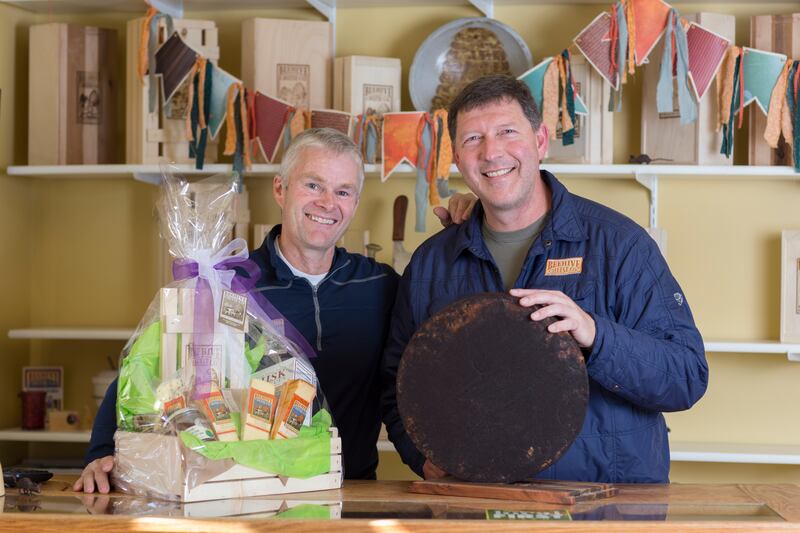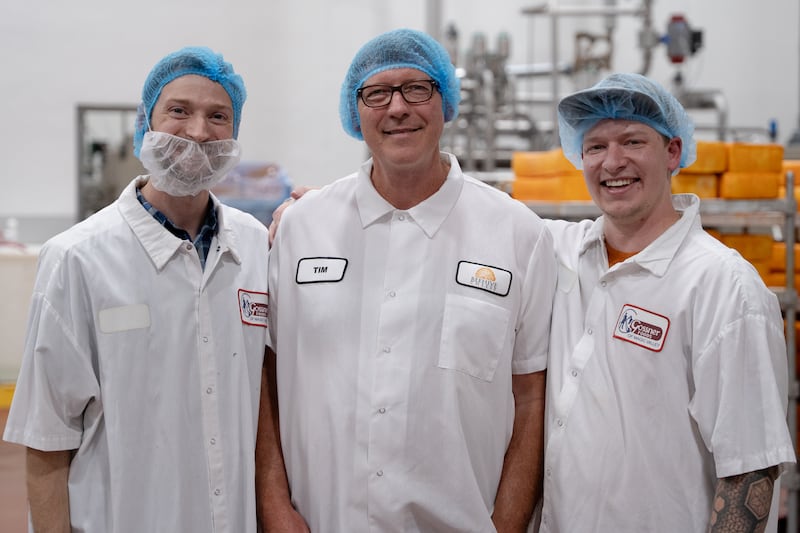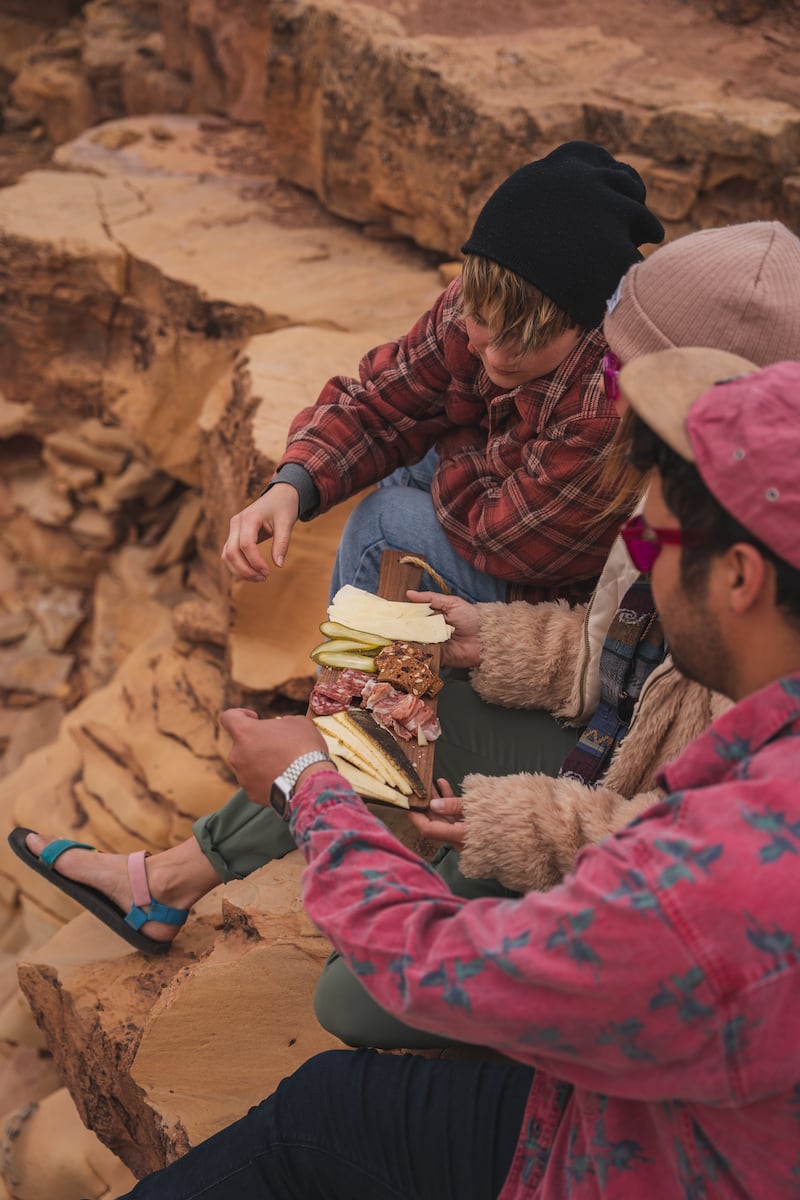This story appears in the October 2025 issue of Utah Business. Subscribe.
The following should come as no surprise: According to an Ngram search of Google Books, there have been several million more instances of the term “innovation in technology” appearing in print than the term “innovation in cheese” (though cheese very briefly took the lead in 1941) since 1900.
It’s true. Cheese was invented many thousands of years ago, and mankind has brought few new things to the realm of dairy. This makes the fact that one of those rare innovations occurred relatively recently and right here in Utah all the more interesting.
An accidental discovery
Tim Welsh made his first wheel of cheese in September of 2005 at the Beehive Cheese creamery in Ogden. A year later, he added coffee to the company’s retail store offerings. Curious but not expecting anything to come of it, Tim rubbed some finely ground coffee on a wheel of cheddar, which he then forgot about. A few months later, he found that wheel and realized he’d created something special.
“I called Utah State University (USU) professor of food science Dr. Donald McMahon and told him what we’d done, and he said, ‘You can’t do that!’ He actually drove down from Logan with two or three of his PhD students the same day to experience it for themselves,” Tim says.
That’s the day Barely Buzzed rind-rubbed cheddar burst onto the scene. Within a year, the American Cheese Society awards — an event normally dominated by Wisconsin creameries — honored the lightly caffeinated dark horse entry from Utah with a first-place ribbon.
Breaking from tradition
“We’re a new-world cheese company, which means we’re not constrained by tradition like old-world cheese makers are,” Tim says. “We wouldn’t have gotten away with that in Europe.”
The timing was impeccable: Beehive Cheese and Barely Buzzed emerged just in time to ride a surging wave of interest in artisan cheeses — and rind-rubbed cheeses in particular — though it may be that the excitement around Barely Buzzed was itself the catalyst of the rind-rubbed renaissance.
“It was so unique and so different and so new that it got a lot of attention,” Tim says. “We had just a little bit of it, which we took to a cheese conference. The first person to taste it was a buyer at Central Market in Texas. He asked for 30,000 pounds. Of course, we said yes. That was more than all the cheese we’d made since we started the company.”

Tim’s path to becoming an artisan cheesemaker was not a direct one. He started on the project management and implementation side of a few financial software companies and reflects on those days with all the passion of someone describing their evening commute. Eventually, he became a partner in a contract software development firm. Business was great, thanks to the growing internet bubble. In 1999, he sold that firm to a Bay Area tech company for a heap of incentive stock options. When the dot-com party ended a few months later, Tim quickly went from being independently wealthy in theory to jobless and out of both stock and professional options in practice.
“Realizing there were no jobs for me in the software business led to my favorite saying: ‘If it is to be, it is up to me.’ And so, I did the obvious thing — I started a cheese company, not knowing the first thing about cheese,” Tim says, suddenly brimming with enthusiasm. “Around 2003, artisan cheese was not really on the map. But the Salt Lake Farmer’s Market started kicking in, and I saw a lot of interest in knowing who is producing your food and the farm-to-table movement. That was a big part of the opportunity I saw.”
Tim wrote a business plan and took a four-day cheese-making course at USU’s Western Dairy Center, taught by McMahon. That relationship would prove pivotal.
“Four types of people take our cheese-making course,” McMahon says. “First, students of food science who want to know more about the practical side of cheese making than they learn in class. Second, the hobbyists who want to try making cheese at home. Third, the experienced cheese makers who want to improve their skills. And finally, every now and then, we get people like Tim and [co-founder Pat Ford] who come from other backgrounds and are looking for a change.”
After taking McMahon’s course a second time, Tim was promoted from the fourth group to the third. He was an established cheesemaker.
“Several months later, we were ready to start making cheese to sell, but the facility we were building wasn’t ready. In the interim, we rented the creamery at USU,” Tim recalls. “We weren’t sure at the time what style of cheese we were going to make, until Dr. McMahon asked us if we would commercialize USU’s cheddar recipe. I thought about that for about 10 seconds before saying yes.”
That recipe would go on to be called Promontory — the foundation of every one of Beehive Cheese’s nine derivative products, each distinguished by what’s rubbed on or infused into them, including porcini mushrooms, truffles, Hatch chiles and bourbon whiskey.
“Artisan cheese makers, if they’re going to be successful, must have some creative flair that differentiates their product from the rest of the market. Because, at the end of the day, you need people to buy your cheese,” McMahon says. “And because artisan cheese is made on a small scale, it’s more expensive. We provided Beehive Cheese with a cheddar recipe that can be made consistently well. We knew that recipe, combined with their creative approach to cheese-making, would make Beehive Cheese successful. And that’s exactly what happened.”

Finding success in the local market
Tim, a Weber County native, takes pride in his Utah roots but is a realist when lamenting the state’s tendency to run a few years behind on the adoption of national trends, including the artisan cheese craze that swept through the rest of the country. He began to wonder if his product’s future lay in other markets.
“We were looking to build a market outside of Utah, thinking we couldn’t sell cheese here,” Tim says. “Then one day, this guy knocks on the door at our creamery and introduces himself as the corporate chef for Harmons grocery stores. He said he was interested in our cheese and wanted to sell it. From that very day, Harmons has been one of our best customers.”
The man at the door was Kyle Lore, currently the corporate chef at Maverik, who, in those days, was on a mission to help Harmons prepare for the impending arrival of Whole Foods, which meant greatly expanding his selection of fresh, locally produced offerings. Lore had traveled to Logan that day to explore a list of Utah creameries, with Beehive Cheese at the top of it.
“They immediately struck me as so innovative, dynamic, well-organized, engaged and friendly,” Lore says. “It was remarkable. That connection started a chef/supplier relationship that outlasted my time at Harmons, because I’ve used their products whenever I can afford to. They’re so supportive. In fact, they lent me their little kitchen for several months when I was starting an artisan pasta company just because they like to support new things.”
As Lore alludes to, Beehive Cheese products do cost more than the pre-sliced stuff sold next to the Lunchables, but he says keeping Beehive Cheese accessible is a high priority for Tim.
“The focus they put into their product would, in many other instances, justify a much higher price and be a very boutique item. But that’s not what they want to be,” Lore says. “They’ve been very good at putting themselves at a price point where they can really make money, without insulting anybody or pushing anybody out.”

Beehive Cheese is a family-run company, and the employee roster includes many Welshes and Fords. Tim remembers the first time he hired a non-family member.
“We hired him because we fired our kids three or four times, and we needed somebody to manage them,” he recalls.
One of those kids was Britton Welsh, who has since gotten his act together and taken on the role any other company would call CEO. However, because the culture at Beehive Cheese (pun intended) discourages titles, he struggled to come up with one when asked, but grudgingly accepts “president.”
Though Tim took a step back from day-to-day management in 2017, Britton says his father remains heavily engaged, noting their approaches to leadership are distinct but complementary.
“The kids are chomping at the bit to get us out of the way so they can move forward,” he says, laughing. “We’re a little too conservative for them.”
Scaling production and committing to corporate responsibility
Cheese-making is an analog industry that will never scale the way digital products do. Each additional wheel of cheese always requires a fixed amount of materials and storage. Tim has found ways to improve margins by innovating the production process.
“We got to a point where we could not expand anymore, so we approached Gossner Foods, a family-owned Swiss cheese maker in Logan, to see if they wanted to form a cheese-making partnership,” Tim says. “That was our way of scaling our business without investing in capital, and it’s turned out to be one of the best things we’ve ever done. We started making four batches a day to get the most out of our equipment. We’ve found ways to improve our process every year.”
In addition to process improvement, Tim values Beehive Cheese’s commitment to improving the world. The company made that mission official by achieving the status of Certified Benefit Corporation — a challenging accomplishment and one only a small handful of Utah companies can claim.

“We were already doing most of the things required to be a Certified B Corp. Now we can share that with the world,” Tim says. “There’s a segment of the market that really cares about corporate responsibility, and when that group sees our B Corp stamp of approval, with all it says about who we are as a company, they support us because of it.”
For Britton, being a certified B Corp is most important for what it says about Beehive Cheese’s commitment to a local audience.
“I intend to keep our B Corp status as a demonstration of our commitment to our people — doing our best to hire internally and help our people to grow and earn a living wage,” Britton says. “That’s super important to me as a leader, but also for what it means to be a part of this company.”
Today’s exotic eventually becomes tomorrow’s ordinary — after all, both cheese and coffee were once received as new technologies before settling in as ubiquitous staples, sitting side by side, for centuries. Their pairing by a former tech exec turned cheese-maker strikes one as surprising, mostly because no one tried it sooner. But it’s fitting, considering rubbing coffee on cheddar works because it’s a product of the same force that drives innovation at Beehive Cheese: the right combination of chemistry and culture.

